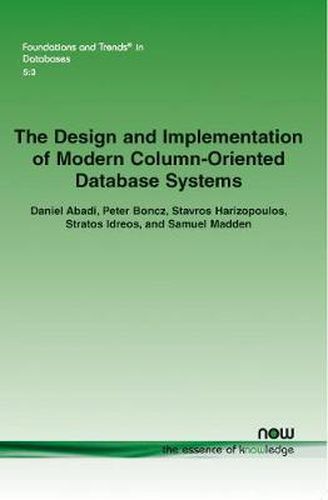Readings Newsletter
Become a Readings Member to make your shopping experience even easier.
Sign in or sign up for free!
You’re not far away from qualifying for FREE standard shipping within Australia
You’ve qualified for FREE standard shipping within Australia
The cart is loading…






This title is printed to order. This book may have been self-published. If so, we cannot guarantee the quality of the content. In the main most books will have gone through the editing process however some may not. We therefore suggest that you be aware of this before ordering this book. If in doubt check either the author or publisher’s details as we are unable to accept any returns unless they are faulty. Please contact us if you have any questions.
Database system performance is directly related to the efficiency of the system at storing data on primary storage (for example, disk) and moving it into CPU registers for processing. For this reason, there is a long history in the database community of research exploring physical storage alternatives, including sophisticated indexing, materialized views, and vertical and horizontal partitioning.
In recent years, there has been renewed interest in so-called column-oriented systems, sometimes also called column-stores. Column-store systems completely vertically partition a database into a collection of individual columns that are stored separately. By storing each column separately on disk, these column-based systems enable queries to readjust the attributes they need, rather than having to read entire rows from disk and discard unneeded attributes once they are in memory.
The Design and Implementation of Modern Column-Oriented Database Systems discusses modern column-stores, their architecture and evolution as well the benefits they can bring in data analytics. There is a specific focus on three influential research prototypes, MonetDB, MonetDB/X100, and C-Store. These systems have formed the basis for several well-known commercial column-store implementations. Their similarities and differences are described and they are discussed in terms of their specific architectural features for compression, late materialization, join processing, vectorization and adaptive indexing (database cracking).
This is an excellent reference on the topic for database researchers and practitioners.
$9.00 standard shipping within Australia
FREE standard shipping within Australia for orders over $100.00
Express & International shipping calculated at checkout
This title is printed to order. This book may have been self-published. If so, we cannot guarantee the quality of the content. In the main most books will have gone through the editing process however some may not. We therefore suggest that you be aware of this before ordering this book. If in doubt check either the author or publisher’s details as we are unable to accept any returns unless they are faulty. Please contact us if you have any questions.
Database system performance is directly related to the efficiency of the system at storing data on primary storage (for example, disk) and moving it into CPU registers for processing. For this reason, there is a long history in the database community of research exploring physical storage alternatives, including sophisticated indexing, materialized views, and vertical and horizontal partitioning.
In recent years, there has been renewed interest in so-called column-oriented systems, sometimes also called column-stores. Column-store systems completely vertically partition a database into a collection of individual columns that are stored separately. By storing each column separately on disk, these column-based systems enable queries to readjust the attributes they need, rather than having to read entire rows from disk and discard unneeded attributes once they are in memory.
The Design and Implementation of Modern Column-Oriented Database Systems discusses modern column-stores, their architecture and evolution as well the benefits they can bring in data analytics. There is a specific focus on three influential research prototypes, MonetDB, MonetDB/X100, and C-Store. These systems have formed the basis for several well-known commercial column-store implementations. Their similarities and differences are described and they are discussed in terms of their specific architectural features for compression, late materialization, join processing, vectorization and adaptive indexing (database cracking).
This is an excellent reference on the topic for database researchers and practitioners.